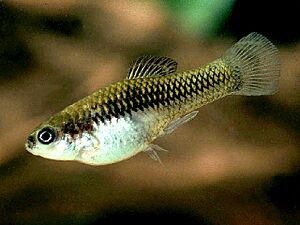Monterrey platyfish facts for kids
Quick facts for kids Monterrey platyfish |
|
|---|---|
 |
|
| Conservation status | |
| Scientific classification | |
| Synonyms | |
|
The Monterrey platyfish (Xiphophorus couchianus) is a small freshwater fish that belongs to the family called Poecilidae. These fish are known as live-bearers, meaning they give birth to live young instead of laying eggs.
This fish used to live in a very small part of the San Juan River system in Mexico. This river system is also part of the larger Rio Grande basin. The fish was named after Darius N. Couch, an American soldier and naturalist who first found it.
Contents
What the Monterrey Platyfish Looks Like
The Monterrey platyfish is not a very colorful fish. It looks quite plain, a bit like a female guppy.
There is another type of this fish, sometimes called X. aff. couchianus. This type was found in Apodaca, a city near Monterrey, in 1983. It has large black spots, which is different from the usual Monterrey platyfish that does not have spots. Scientists are still trying to figure out if this spotted type is a separate species.
Size Differences Between Males and Females
Male and female Monterrey platyfish look a bit different in size. This is called Sexual dimorphism. Male fish grow to about 4 cm (1.6 in) long. Female fish are larger, growing up to 6 cm (2.4 in) long.
Conservation Efforts to Save the Species
The IUCN (International Union for Conservation of Nature) lists the Monterrey platyfish as "extinct in the wild". This means that it no longer lives in its natural habitat.
Why the Monterrey Platyfish Disappeared
The Monterrey platyfish used to be found in more places around Monterrey. However, its populations disappeared because of urban sprawl. This is when cities grow bigger and take over natural areas.
Water habitats either dried up or became very polluted. This happened because land was changed for building, and too much water was taken from the rivers. Also, new fish species were brought into the area. These new fish were another threat to the Monterrey platyfish.
Keeping the Species Safe in Captivity
Even though the Monterrey platyfish is gone from the wild, some "safety populations" are kept alive in special places. These places include:
- The Centro de Resguardo para Peces en Peligro de Extinción at Universidad Autónoma de Nuevo León in Mexico. They keep both the typical form and the spotted X. aff. couchianus.
- The Xiphophorus Genetic Stock Center at Texas State University in the United States. They keep the typical form.
- Private fish keepers in the United States, who are part of the American Livebearer Association. They also keep the typical form.
- Members of the XNP conservation project in Europe and the United States. This group includes public aquariums, universities, and private fish keepers. They also keep the typical form.
It has been harder to keep the Monterrey platyfish alive in captivity compared to other Xiphophorus species.
Related Fish Species in Danger
The Monterrey platyfish is one of the northernmost Xiphophorus species. Two other closely related species also live in northeastern Mexico and are seriously threatened. These are the northern platyfish (X. gordoni) and the marbled swordtail (X. meyeri).


